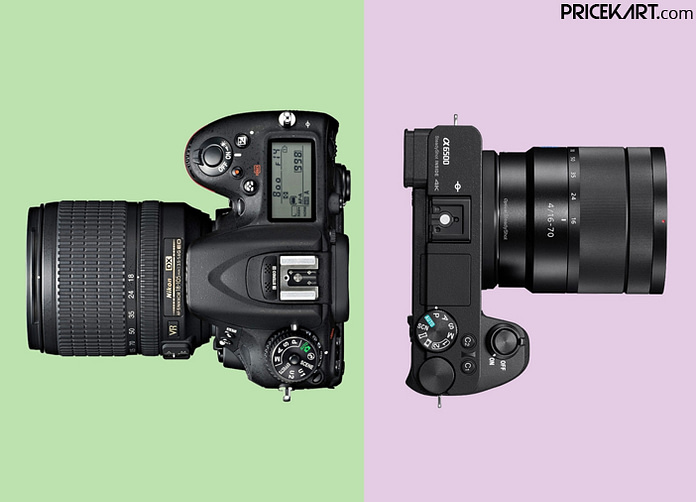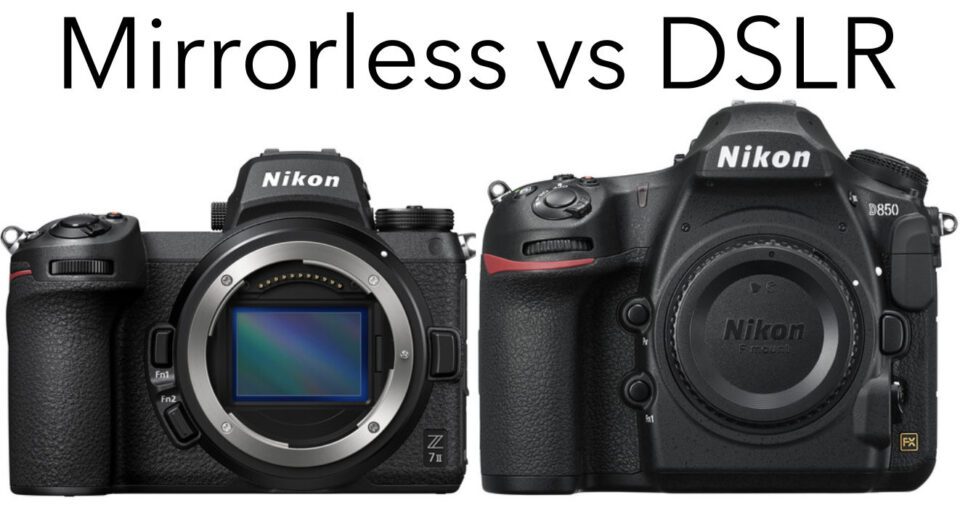When mirrorless cameras started to replace DSLRs, there were still many advantages of a DSLR over mirrorless. Now that mirrorless cameras have matured, there are very few clear technical advantages of using a DSLR, although DSLRs are still very capable for most types of photography.
Can’t decide between a mirrorless and a DSLR camera? In this comprehensive article, we will take a close look at pros and cons of both DSLR and mirrorless cameras in detail and provide some recommendations on which route to take in the future. So, what is the role of the DSLR in a mirrorless world? How do these two types of cameras compare today?
The DSLR
DSLR (digital single lens reflex) cameras have a mechanical mirror, a phase-detection autofocus system, and an optical viewfinder with a pentamirror or pentaprism design.
DSLRs are a continuation of SLR cameras that were initially developed for film. When digital sensors evolved, camera companies treated them a lot like film and housed them in the same type of mechanical body. Many aspects of a DSLR’s construction are similar to that of a film SLR.
While technological advances eventually led to new features added to DSLRs (GPS, WiFi, HDR, etc), DSLRs continued to stay bulky and mechanically complex, mostly due to the optical viewfinder. After all, a DSLR’s optical viewfinder only works thanks to a reflex mirror in front of the camera sensor, which reflects light into a pentaprism or pentamirror above the sensor, outputting in the viewfinder. All of these components are large and bulky. Despite the best efforts of companies like Canon and Nikon, DSLRs could only get so small.
Just as importantly, camera manufacturers wanted their existing lenses to remain compatible with digital cameras, in order to ease the transition from film to digital. The problem is that this confined DSLRs to certain sizes and shapes in order to maintain compatibility with legacy lenses. (Specifically, the lens mount and the flange distance needed to stay the same dimensions as before.) This once again prevented camera companies from slimming down their DSLRs.
Still, DSLRs became wildly popular in the digital age, especially before smartphones caught up to being “good enough” for a lot of non-pro photographers. For years, high-quality photography was practically interchangeable with the DSLR. It’s only in recent years that mirrorless cameras have begun to outpace them.
DSLR Camera Advantages
Even in a mirrorless world, DSLRs still have some advantages:
- Beautiful optical viewfinder: Mirrorless cameras (and their electronic viewfinders) will never be able to replicate the experience of an optical viewfinder: natural, instantaneous, through-the-lens, and real.
- Long battery life: Because the optical viewfinder is, indeed, optical instead of electronic, it requires almost no power to run. Only the little displays like camera settings draw any power. So, DSLRs have great battery life, so long as you use their viewfinder and not their rear LCD screen.
- Low used prices: Many people are switching to mirrorless cameras, so it’s easy to get a great deal on a lightly-used DSLR.

DSLR Camera Limitations
Due to the mirror dependency of DSLRs, they have the following limitations:
- Size and bulk: The viewfinder system needs space for both the mirror and the prism, which means that DSLRs will always have a pretty deep camera body and a protruding top. It also means that the viewfinder must be fixed in the same spot on every DSLR, in line with the optical axis and digital sensor – basically, there is no other place to put it. As a result, most DSLRs have somewhat similar exterior looks.
- Weight: Large size and bulk also translates to more weight. While most entry-level DSLRs have plastic bodies and internal components to make them lighter, there’s only so small a DSLR can be.
- Complex mirror and shutter design: Every time you take a photo with a DSLR, the mirror must move out of the way to allow light to hit the camera sensor. This alone creates a number of issues:
- Mirror slap: DSLR cameras produce quite a bit of noise and vibration when the mirror moves out of the way. Although manufacturers have been coming up with creative ways to reduce this issue (Nikon’s “Quiet” mode for example), it is still a problem. For tripod-based photography, you will often want to use “Mirror Lock-Up” or “Exposure Delay” to allow mirror to be lifted, then exposure taken after a set delay – all to reduce mirror-induced vibrations.
- Frame speed limitation: Modern mirror and shutter mechanisms are very impressive, but they are limited by the physical speed at which the mirror flips up and down. For example, when the Nikon D6 fires at 14 frames per second, the mirror goes up and down 14 times within each second, with the shutter opening and closing in between! This means there needs to be perfect synchronization of both the mirror and the shutter. Take a look at this video that shows this in slow motion. It’s an amazing technology, but it’s expensive, and it severely limits the frames per second of most cameras.
- Expensive to build and support: The mirror mechanism is complex and consists of dozens of different parts. Because of that, it is expensive to build and provide technical support if anything goes wrong. Disassembling a DSLR and replacing internal components can be very time-consuming for a service center.
- No exposure preview in the viewfinder: When looking through an optical viewfinder (OVF), it is impossible to see exactly what the final image will look like. You have to look at the camera meter (which can be fooled in some situations) or the LCD in live view mode if you want an idea of the exposure.
- Secondary mirror and phase detection accuracy: DSLR cameras with a phase-detection autofocus system require a secondary mirror. I wrote about this in detail in my “how phase-detection AF works” article. The problem with the secondary mirror is that it has to be positioned at a perfect angle and distance for phase detection autofocus to work accurately. If there is even a slight deviation, it will result in missed focus. And even worse, the phase detection sensors and the secondary mirror have to stay perfectly parallel to each other. If they don’t, some autofocus points might be accurate, while others will constantly miss focus.
- Phase detection and lens calibration issues: The same problem with phase-detection systems extends to camera lenses, which need to be properly calibrated for each DSLR body. If you have autofocus problems on a DSLR, very often, support techs will ask the lens in question to be sent together with the camera body. If the technician adjusts your lens to their standard camera environment and your camera is slightly off, your issues might get even worse after such tuning.
- Complexity: Although manufacturers have gotten much more efficient over the years in terms of DSLR production, assembling the mirror mechanism is no easy task. Lots of moving components mean high precision assembly systems, the need for lubrication in areas where metal components rub against each other, and so on. In turn, this all results in increased manufacturing costs. DSLR cameras are relatively inexpensive because they’ve been around for a while, and camera companies have honed their manufacturing, but they’re still more mechanically complex than a mirrorless camera.

The Mirrorless Camera
Fundamentally, the only thing a mirrorless camera does differently than a DSLR is remove the mirror. But that one change allows mirrorless cameras much more flexibility in their design and features, not to mention reduce the number of moving parts in the camera (helpful for reducing the camera’s price, either for the manufacturer, consumer, or both).
Any camera without a mirror is technically a mirrorless camera, including something like a smartphone. However, the term “mirrorless” is usually a shortened way of referring to “mirrorless interchangeable lens cameras,” AKA mirrorless ILCs. Like the DSLR, you can change lenses on a mirrorless camera in order to expand your creative options.
With the rise of mirrorless cameras (a phenomenon that gradually picked up steam in the late 2010s), most camera manufacturers except Pentax have have transitioned away from DSLRs. Although some DSLR models are still available from Nikon and Canon, neither company has produced a new DSLR in a while. They’re focused on mirrorless.

Mirrorless Camera Advantages
Mirrorless cameras have opened up huge opportunities for innovation and have solved many of the problems of traditional DSLRs. They’re still not perfect cameras, but these are some of their main advantages:
- Smaller size and lighter weight: Removing the mirror and the pentaprism frees up a lot of space. This means that mirrorless cameras can be designed to be smaller, less bulky, and lighter compared to DSLRs. Not every mirrorless camera is lighter than every DSLR (see the Nikon Z9, Panasonic S1R, and Canon EOS R3 for three examples of large mirrorless cameras). But they’re definitely lighter on average. Here’s an example of the weight savings between a DSLR versus comparable mirrorless cameras:
DSLRComparable MirrorlessWeight SavingsCanon 5D Mark IVCanon R5152g (5.4oz)Canon 7DIICanon R7298g (10.5oz)Nikon D850Nikon Z7II300g (10.6oz)Nikon D6Nikon Z9110g (3.9oz) - No mirror mechanism: There are a few benefits here:
- Quieter: No more mirror slap, and if you are using an electronic shutter, you can shoot almost completely silently.
- Less camera shake: The only physical component in the mirrorless camera that can cause vibrations is the camera shutter. And even then, it is possible to use electronic shutter to completely get rid of camera shake from the shutter mechanism. (Some DSLRs can do this in live view.)
- Easier to clean: If dust ends up on the sensor, cleaning mirrorless cameras is easier than DSLRs. It’s easier to see a mirrorless sensor when cleaning it, and dust that you remove (say, with a rocket blower) doesn’t settle back into the camera chamber as easily.
- Very fast FPS speed: Unlike DSLRs which topped out at around 10-14 frames per second, mirrorless cameras can shoot at 20fps, 30fps, or even higher numbers like 120fps for still photography, since there’s no mirror that needs to move for every photo.
- Cheaper to build and support: With fewer moving parts, a camera can be priced more competitively. We have seen this with the Nikon Z9, which lacks a mirror and has no physical shutter curtain, while costing less than its competitors.
- Better and smarter autofocus: It took a while for mirrorless to catch up to DSLRs for autofocus capabilities, but we’re now at the point where the average mirrorless camera arguably beats the average DSLR for autofocus. Mirrorless cameras have hybrid phase-contrast detect systems not found on most DSLRs, and camera companies are now putting most of their autofocus R&D into mirrorless cameras. The artificial-intelligence autofocus systems and subject-detection on modern mirrorless cameras are a sight to behold.
- Wider spread of autofocus points: Most DSLR cameras have a limited number of focus points that are distributed mostly around the center of the frame. What do you do if you need to move the focus point to an extreme border of the frame? The only option is to focus and recompose, which isn’t a perfect technique. With mirrorless cameras, autofocus points are distributed across the frame, so even if your subject is in the very corner, you can easily focus on it. (Some DSLRs have this option in live view, but live view autofocus speed/tracking is a joke on most DSLRs.)
- Image preview in the viewfinder: With mirrorless cameras, you can get an exact preview of your photos in the viewfinder. In other words, if you brighten the exposure, change white balance, etc., it’s like looking at how those changes apply to your final photos. DSLRs are only like this on their rear LCD.
- No phase detection / secondary mirror alignment issues: A long-standing problem of DSLRs was focus calibration when shooting through the viewfinder. Mirrorless cameras don’t have that problem, because they read the autofocus information directly from the camera’s sensor. This means more precise autofocus through the viewfinder, and fewer issues with poorly-calibrated lenses.
- Access to newer lenses: The best innovations in lens design recently have been for mirrorless lenses. Glass like Nikon’s S-line lenses or Canon’s mirrorless L lenses are some of the best we’ve ever tested. It helps that lens designers have more flexibility with mirrorless lenses, which sit much closer to the camera sensor. (Nikon and Canon also have much larger lens mounts for mirrorless than they did for DSLRs, which gives their lens designers even more room to work with.)
- Mirrorless is where companies are innovating: Do you want the newest video specifications, fastest processing power, and any other new features that camera companies invent? Almost all of those new features are going into mirrorless cameras, not DSLRs. This isn’t due to any fault with the design of DSLRs; it’s just where camera companies are focusing their attention these days.
- Electronic viewfinder: Without a doubt, an electronic viewfinder (EVF) has huge advantages over an optical viewfinder (OVF), even though some photographers love the look and feel of their OVF. Some of the key benefits are:
- Information overlay: With a DSLR’s viewfinder, you can’t overlay any information other than basic grids and focus points. (Limited camera settings are usually shown right below that.) With an EVF on a mirrorless camera, you can see all sorts of information in the viewfinder, like live exposure data, histograms, waveforms, zebra stripes, and horizon indicators.
- Image review: Another key feature that you will never get in an OVF is image review. How cool is it to see the image that you have just captured right inside the viewfinder? On a DSLR, you need to look at the LCD screen to review an image, which is a big pain in bright conditions. People end up buying specialized loupes just to be able to see their LCD screen in daylight! With the EVF of a mirrorless camera, you never have to worry about this, since you can use the viewfinder for reviewing images instead.
- Focus peaking and zooming: A very useful feature that allows you to see what areas of the frame are in focus. Basically, you can nail focus when performing manual focus more easily on a mirrorless camera. It’s much tougher on a DSLR.
- No more viewfinder coverage issues: With an OVF, you typically get something like 95% viewfinder coverage, especially on lower-end DSLR models. This means that you’re not seeing the whole frame when you take a picture; you end up capturing a bit extra around the edges. With an EVF, you no longer have this problem, because it will always be 100% viewfinder coverage. This makes composition much easier.
- Brighter display: If there is very little light, you cannot see much through an OVF. Focusing with OVF in low light is also difficult because you cannot easily tell if the subject is in focus until you take the picture. With an EVF, brightness levels can be boosted in low light, so that you can see everything as if it were daylight. Some image noise might be present, but it’s still way better than trying to guess when looking through an OVF.
- Eye damage: when looking through a viewfinder, you have to be extremely careful about photographing the sun, especially with long focal length lenses. You can burn your retina in just a fraction of a second. With an EVF, you’re just looking at an LCD screen, so there is no harm to your eyes; you’re not looking directly at the sun, just at, essentially, a photo of it.

Mirrorless Camera Limitations
We’ve gone over the many advantages of mirrorless cameras over DSLRs. Now let’s talk about some of their current limitations.
- EVF lag: Some early or lower-end mirrorless cameras have low-quality EVFs that are not very responsive and have some lag. By comparison, an OVF on a DSLR is instantaneous. While this is certainly a nuisance if you have one of those cameras, more recent EVFs are quite good, and most people aren’t bothered by them.
- Red dot patterns: Due to the very short flange distance on a mirrorless camera, most of them suffer from a “red dot pattern” issue, which becomes clearly visible when shot with the sun in the frame at small apertures. Basically, light rays bounce back and forth between the sensor and the rear lens element, creating grid patterns of red (and sometimes other colors) in images. Unfortunately, there is no easy way around this limitation on mirrorless cameras.
- Flash head autofocus-assist beam: The AF-assist beam on most flash heads projects infrared light onto your subject, and then uses it to focus. This works fine on DSLRs with their phase-detect focusing systems, which are sensitive to infrared light. Unfortunately, it doesn’t work for mirrorless cameras. In low-light situations, if you’re used to using a flash, you may find that focusing gets more difficult if you switch to mirrorless. (On most flashes, mirrorless cameras refuse to even fire the AF assist light at all.)
- Price: In theory, producing mirrorless cameras can be cheaper than producing DSLRs, thanks to fewer moving parts. Occasionally this translates into less expensive mirrorless cameras, like the Nikon Z9 compared to its DSLR counterpart, the Nikon D6. However, most mirrorless cameras sell for a premium over their DSLR counterparts, precisely because of all the R&D dollars that camera companies are pouring into them. Over time, mirrorless camera prices will come down, but for now, DSLRs usually win in price. Used DSLRs are perhaps the best value of any segment of the camera market today.
- Battery life: Most mirrorless cameras still use more power than their DSLR counterparts, largely because of their electronic viewfinders. The result is that mirrorless cameras are rated for fewer photos per charge than most DSLRs. Although mirrorless cameras are getting better in this department, it can still be a problem for someone who travels and has very little access to power. The good news is that today’s mirrorless cameras can usually last a full day without recharging, which was a major threshold. Still, you can see the differences here:
| DSLR | CIPA Shots Per Charge | Comparable Mirrorless | CIPA Shots Per Charge |
|---|---|---|---|
| Canon 5D Mark IV | 900 | Canon R5 | 320 |
| Canon 7DII | 670 | Canon R7 | 660 |
| Nikon D850 | 1840 | Nikon Z7 | 420 |
| Nikon D6 | 3580 | Nikon Z9 | 740 |
When I first wrote this article, the list of mirrorless disadvantages was longer, but with the most recent update of the article, I had to delete some of them. Mirrorless technology has already gotten much better, and I expect mirrorless cameras to continue improving within the next few years.
DSLRs no longer compete with mirrorless cameras since aside from Pentax, camera companies have stopped designing new ones. Although many people will still use and even buy DSLRs for many years to come, the majority of new camera sales are now mirrorless.

Future Innovation for Mirrorless Cameras
In terms of innovation, everything is concentrated in the mirrorless realm. Mirrorless cameras will continue to provide many more exciting features because the possibilities are truly endless. A lot can be done with EVFs and autofocus systems alone, thanks to advancements in display technologies and on-sensor data analysis.
In the realm of autofocus, mirrorless cameras like the Nikon Z9 already perform very well. But with faster processors and more advanced machine-learning algorithms, autofocus and subject recognition will only improve. Imagine a system that would immediately jump to a rare bird in a flock of common ones or one that would never lose its focus lock even through the most challenging of situations.
Video is another area that is rapidly improving, but video autofocus can still improve further. Video stabilization algorithms will also become better with faster processing, perhaps one day replacing the gimbal for most videographers. Additionally, with faster sensors and processing, framerates will increase. Many cameras already do 240fps video, but that is still not fast enough for some types of movement, like flying insects.
In-camera post-processing also has more potential to improve. Smartphone manufacturers have utilized such techniques to compensate for the smaller sensors in phones, but camera manufacturers could do much more. We have a list here of some features that more cameras should have. Today’s mirrorless companies are already chipping away at that list!

What About the DSLR?
With all the advancements in the mirrorless domain, it can’t be denied that DSLRs are still very capable photographic tools. The distance between the best mirrorless cameras and the best DSLRs is much less than the distance between DLSRs and film cameras.
Since so many people have switched to mirrorless now, there are also thousands of lightly used DSLRs on the used market, including some amazing cameras like the D850 or Canon 5D IV. Thus a DSLR could still be the right camera for you. In fact, quite a few photographers still use DSLRs exclusively or in addition to their mirrorless cameras, and this will probably not change for many years to come.
Finally, Pentax is at least one company that still believes in the DSLR. So although mirrorless is certainly where most camera companies are focusing, the DSLR isn’t quite dead yet!

Conclusion
Although few things could be improved with mirrorless cameras, such as better battery life and lower prices, mirrorless cameras are getting pretty hard to beat. And that’s partly because camera companies want it to be that way. With the exception of Pentax, every camera company is pouring all their new features and innovations into the mirrorless side, even if some of those features would also have been nice on DSLRs (like the high-end video or autofocus features).
Currently, it is still possible to get a DSLR new, but one day, the only choice for a new camera will be a mirrorless one. That doesn’t mean you need to get a mirrorless camera yet, but if you choose to buy a DSLR today, at least be aware of the pros and cons I covered in this article.
What do you think about the question of DSLR vs mirrorless cameras? Please share your thoughts below!





